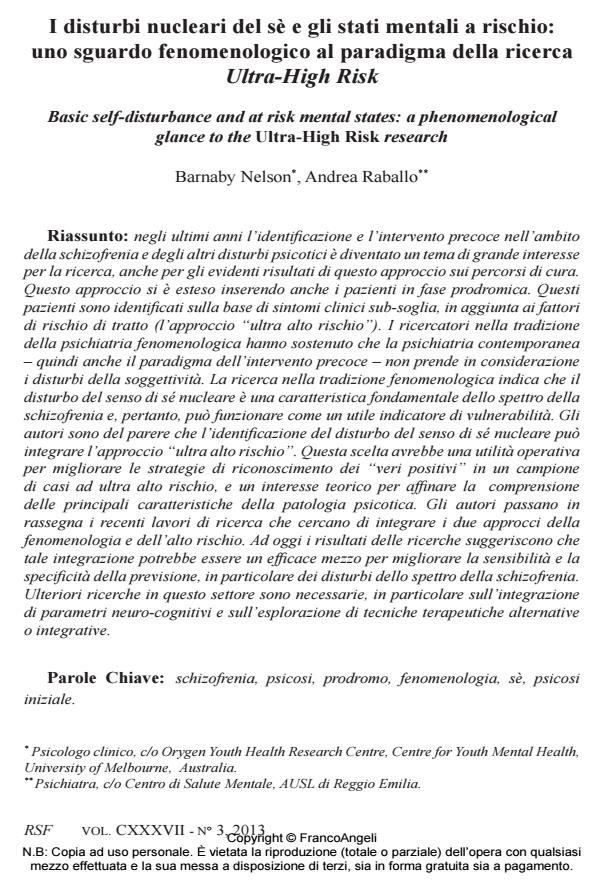Basic self-disturbance and at risk mental states: a phenomenological glance to the Ultra-High Risk research
Journal title RIVISTA SPERIMENTALE DI FRENIATRIA
Author/s Barnaby Nelson, Andrea Raballo
Publishing Year 2013 Issue 2013/3
Language Italian Pages 33 P. 97-129 File size 440 KB
DOI 10.3280/RSF2013-003006
DOI is like a bar code for intellectual property: to have more infomation
click here
Below, you can see the article first page
If you want to buy this article in PDF format, you can do it, following the instructions to buy download credits

FrancoAngeli is member of Publishers International Linking Association, Inc (PILA), a not-for-profit association which run the CrossRef service enabling links to and from online scholarly content.
Over the last decade early detection and intervention of schizophrenia and other psychotic disorders has become a central research and clinical theme. The early intervention approach includes patients in the prodromal phase identifying sub-threshold clinical symptoms and trait risk factors ("ultra high risk" approach). Phenomenological psychiatry researchers have argued that contemporary psychiatry and the early intervention paradigm neglect the disturbances of subjectivity. Phenomenological research underlines that disturbance of the basic sense of self is a core feature of the schizophrenia spectrum and may therefore function as a vulnerability marker. The authors suggest that identifying disturbance of the basic sense of self may enrich the ultra high risk detection approach. This choice would be of practical value for enhancing the identification of "true positive" cases in ultra high risk samples, and of theoretical value for sharpening the understanding of the core features of psychotic pathology. The authors review the current research that attempts to integrate the phenomenological approach with the ultra high risk approach. So far research results suggest that such an integration may represent an effective way to enhance the sensitivity and specifity of prediction, particularly in the spectrum of schizophrenia. The authors recommend future research in this area, particularly in the field of inclusion of neurocognitive parameters and the exploration of alternative or complementary therapeutic techniques.
Keywords: Schizophrenia, psychosis, prodrome, phenomenology, self, early psychosis.
- Early Intervention Services for youth at Clinical High-Risk for Psychosis: The Reggio Emilia At-Risk Mental State (ReARMS) experience Michele Poletti, in RIVISTA SPERIMENTALE DI FRENIATRIA 3/2022 pp.61
DOI: 10.3280/RSF2022-003004 - Esordi psicotici in adolescenza e giovane età adulta: prospettive teoriche e di trattamento Federica Paterlini, in RIVISTA SPERIMENTALE DI FRENIATRIA 3/2022 pp.31
DOI: 10.3280/RSF2022-003003
Barnaby Nelson, Andrea Raballo, I disturbi nucleari del sè e gli stati mentali a rischio: uno sguardo fenomenologico al paradigma della ricerca Ultra-High Risk in "RIVISTA SPERIMENTALE DI FRENIATRIA" 3/2013, pp 97-129, DOI: 10.3280/RSF2013-003006